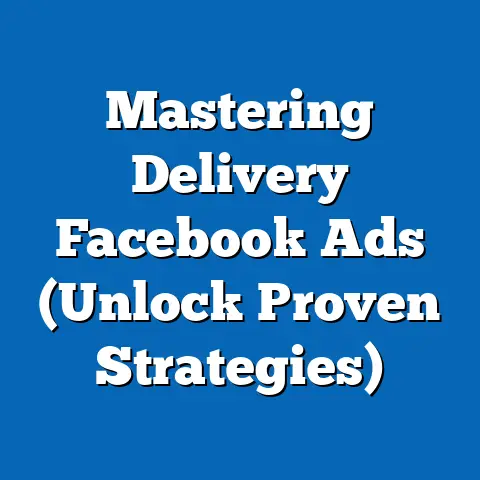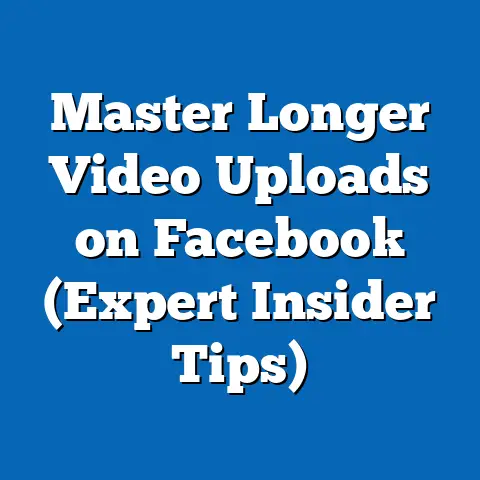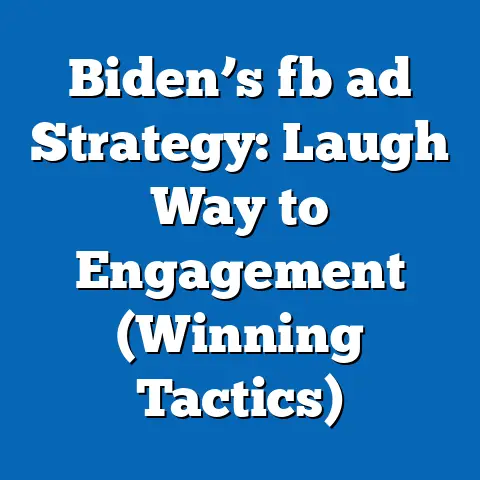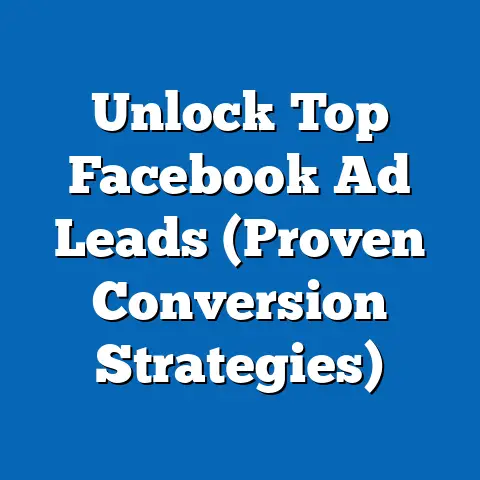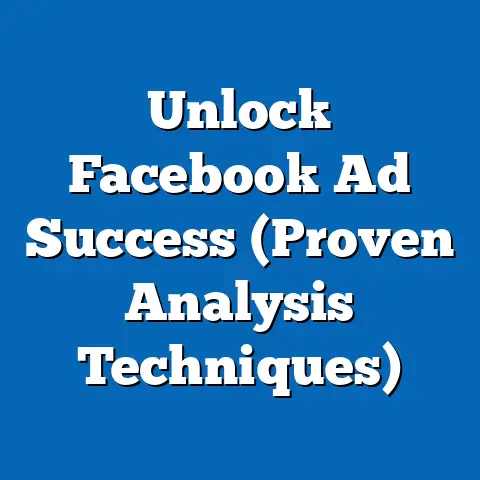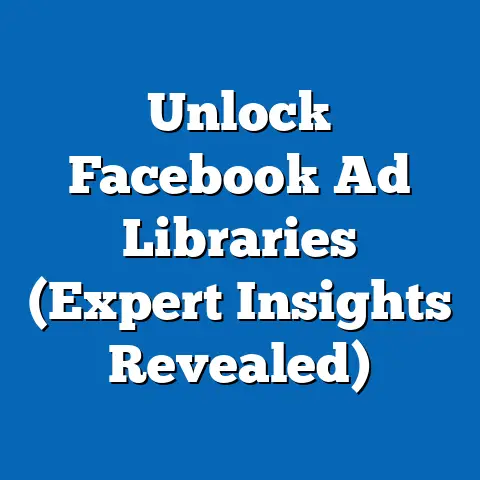Boost Retail Sales with Facebook Ads (Strategic Empowerment)
In today’s fast-paced world, comfort is king, especially when it comes to shopping. The rise of e-commerce and social media has fundamentally changed how consumers interact with brands and make purchasing decisions. No longer are they confined to the limitations of brick-and-mortar stores; they can browse, compare, and buy products from the comfort of their own homes, at any time of day or night. This shift towards online shopping has made it a crucial aspect of modern retail, and for retailers, understanding and leveraging the power of digital advertising is no longer an option – it’s a necessity.
That’s where Facebook Ads comes in. As a digital marketing expert who’s spent years helping businesses grow through online advertising, I can confidently say that Facebook Ads is one of the most powerful tools available to retailers today. It’s not just about reaching your target audience; it’s about enhancing their shopping experience through personalized, engaging, and ultimately, comfortable advertising strategies. In this guide, I’ll walk you through the Facebook Ads ecosystem, showing you how to craft compelling content, target the right audience, leverage data insights, and learn from successful retailers who have already cracked the code. Get ready to strategically empower your retail business with the power of Facebook Ads.
Understanding the Facebook Ads Ecosystem
Before you can launch a successful Facebook Ads campaign, it’s crucial to understand the lay of the land. The Facebook Ads ecosystem is a complex but powerful machine, and knowing how each part works will give you a significant advantage.
Ad Formats: Choosing the Right Visuals
Facebook offers a variety of ad formats, each designed to achieve different goals and appeal to different audiences. Here are some of the most popular options for retailers:
- Image Ads: These are the simplest format, consisting of a single image or video with accompanying text. They’re great for showcasing a single product or highlighting a specific offer.
- Video Ads: Video ads are incredibly engaging and can be used to tell a story, demonstrate a product, or capture attention in a visually appealing way.
- Carousel Ads: Carousel ads allow you to showcase multiple products or features in a single ad unit. Users can scroll through the carousel to see different images or videos, each with its own headline, description, and link. This is a great option for showcasing a range of products or telling a story with multiple parts.
- Collection Ads: Collection ads are designed specifically for mobile shoppers. They feature a cover image or video, followed by a selection of related products. When users click on the ad, they’re taken to a full-screen experience where they can browse and purchase products.
- Instant Experience Ads: These full-screen, mobile-optimized ads load instantly and offer a highly immersive experience. They can include videos, images, carousels, and more, allowing you to create a rich and engaging ad experience.
I’ve personally found that carousel ads and collection ads are particularly effective for retail clients, as they allow you to showcase multiple products and drive traffic directly to your product pages.
Facebook Ads Manager: Your Control Center
The Facebook Ads Manager is the central hub for creating, managing, and analyzing your Facebook Ads campaigns. It’s where you’ll set your budget, choose your targeting options, design your ads, and track your results.
Navigating the Ads Manager can be a bit overwhelming at first, but once you get the hang of it, it’s an incredibly powerful tool. Here are some of the key features you’ll want to familiarize yourself with:
- Campaign Objectives: Choose the right campaign objective to align with your marketing goals. Options include awareness, traffic, engagement, leads, app promotion, and sales.
- Ad Sets: Ad sets allow you to define your target audience, budget, and schedule for each campaign. You can create multiple ad sets within a single campaign to test different targeting options or ad creatives.
- Ads: This is where you’ll design your individual ads, choosing your ad format, writing your copy, and uploading your visuals.
- Reporting: The Ads Manager provides detailed reporting on your campaign performance, including metrics like impressions, reach, clicks, conversions, and cost per result.
I remember when I first started using Ads Manager, I was intimidated by all the options and settings. But after spending some time experimenting and learning, I realized that it’s actually a very intuitive and user-friendly platform. Don’t be afraid to dive in and explore!
Targeting Capabilities: Finding Your Ideal Customer
One of the biggest advantages of Facebook Ads is its incredibly powerful targeting capabilities. You can target your ads based on a wide range of factors, including:
- Demographics: Target users based on age, gender, location, education, job title, and more.
- Interests: Target users based on their interests, hobbies, and passions.
- Behaviors: Target users based on their online behavior, such as their purchase history, device usage, and travel habits.
- Custom Audiences: Create custom audiences based on your existing customer data, such as email lists, website visitors, or app users.
- Lookalike Audiences: Expand your reach by targeting users who are similar to your existing customers.
For example, if you’re selling women’s clothing, you could target women aged 25-45 who are interested in fashion, shopping, and online retail. Or, you could create a custom audience of your existing customers and then create a lookalike audience to reach new customers who are similar to them.
Understanding the Facebook Ads ecosystem is the foundation for a successful campaign. By choosing the right ad formats, mastering the Ads Manager, and leveraging the platform’s targeting capabilities, you can create ads that resonate with your audience and drive real results.
Key Takeaway: Take the time to explore the Facebook Ads Manager and familiarize yourself with the different ad formats and targeting options. The more you understand the platform, the better equipped you’ll be to create effective campaigns.
Crafting Compelling Ad Content
Now that you understand the Facebook Ads ecosystem, let’s talk about the heart of your campaign: the ad content itself. No matter how well you target your ads, they won’t be effective if the content isn’t compelling and engaging.
High-Quality Visuals: Capturing Attention
In the world of Facebook Ads, visuals are king. Your images or videos are the first thing that users will see, so it’s crucial to make them eye-catching and relevant.
Here are some tips for creating high-quality visuals:
- Use professional-quality images and videos: Avoid blurry or pixelated images.
- Choose images that are relevant to your product or service: Don’t use stock photos that don’t accurately represent your brand.
- Use bright, vibrant colors: Colors can evoke emotions and draw attention to your ads.
- Consider using lifestyle images: Show your product in use or in a real-world setting.
- Test different visuals to see what resonates best with your audience: A/B testing is your friend!
I’ve seen firsthand how the right visual can make or break an ad. For one of my retail clients, we tested two different images for the same ad. One image was a simple product shot, while the other was a lifestyle image showing the product being used in a fun and engaging way. The lifestyle image outperformed the product shot by over 200%!
Engaging Copy: Telling Your Story
While visuals are important, your ad copy is what will ultimately persuade users to take action. Your copy should be clear, concise, and compelling, highlighting the benefits of your product or service and creating a sense of urgency.
Here are some tips for writing engaging ad copy:
- Start with a strong headline: Your headline should grab attention and entice users to read more.
- Highlight the benefits, not just the features: Tell users how your product or service will make their lives better.
- Use persuasive language: Words like “limited-time offer,” “exclusive,” and “guaranteed” can create a sense of urgency and scarcity.
- Keep it short and sweet: People are scrolling quickly through their newsfeeds, so get to the point.
- Speak to your target audience: Use language that resonates with them and addresses their specific needs and pain points.
Clear Calls-to-Action (CTAs): Guiding Users to Take Action
Your call-to-action (CTA) is the final piece of the puzzle. It tells users what you want them to do next, whether it’s visiting your website, making a purchase, or signing up for your email list.
Here are some tips for creating effective CTAs:
- Use strong action verbs: Words like “Shop Now,” “Learn More,” and “Get Started” are clear and direct.
- Make your CTA stand out: Use a contrasting color or a button to draw attention to your CTA.
- Create a sense of urgency: Words like “Limited Time Offer” or “Shop Now Before It’s Gone” can encourage users to take action immediately.
- Test different CTAs to see what performs best: Experiment with different wording, colors, and placements.
The Power of Storytelling: Connecting Emotionally
In today’s crowded marketplace, it’s not enough to simply sell products; you need to connect with your audience on an emotional level. That’s where storytelling comes in.
By telling stories that resonate with your target audience, you can create a deeper connection and build brand loyalty. For example, you could share stories about your company’s founding, your commitment to sustainability, or the impact your products have on people’s lives.
One of my favorite examples of storytelling in advertising is the Dove Real Beauty campaign. By featuring real women of all shapes and sizes, Dove challenged traditional beauty standards and created a powerful message of self-acceptance. This campaign not only resonated with consumers but also helped to build a strong and loyal customer base.
Aligning with Brand Voice and Values: Building Trust
Your ad content should always align with your brand’s voice and values. This will help you to build trust with your audience and create a consistent brand experience.
If your brand is known for being fun and playful, your ads should reflect that. If your brand is known for being serious and professional, your ads should reflect that as well.
Key Takeaway: Crafting compelling ad content is essential for driving results with Facebook Ads. By using high-quality visuals, engaging copy, clear CTAs, and the power of storytelling, you can capture attention, connect with your audience, and ultimately, drive sales.
Strategic Targeting for Retail Success
Crafting compelling ad content is only half the battle. You also need to make sure that your ads are being seen by the right people. That’s where strategic targeting comes in.
Audience Insights and Analytics: Understanding Your Market
Before you start targeting your ads, it’s important to understand your market. Who are your ideal customers? What are their interests, behaviors, and demographics?
Facebook offers a variety of tools to help you gather this information, including:
- Facebook Audience Insights: This tool provides detailed information about the demographics, interests, and behaviors of your Facebook audience.
- Facebook Analytics: This tool allows you to track user behavior on your website and app, giving you valuable insights into how people are interacting with your brand.
- Customer Surveys: You can use surveys to gather direct feedback from your customers about their preferences and needs.
By analyzing this data, you can create a detailed profile of your ideal customer and use that information to target your ads more effectively.
Custom Audiences: Reaching Your Existing Customers
Custom audiences allow you to target your ads to people who have already interacted with your brand. You can create custom audiences based on:
- Email Lists: Upload your email list to Facebook and target your ads to those users.
- Website Visitors: Target your ads to people who have visited your website.
- App Users: Target your ads to people who have downloaded and used your app.
- Engagement: Target your ads to people who have engaged with your Facebook page or ads.
Custom audiences are incredibly powerful because you’re targeting people who are already familiar with your brand and are more likely to convert.
Lookalike Audiences: Expanding Your Reach
Lookalike audiences allow you to expand your reach by targeting people who are similar to your existing customers. Facebook uses its data to identify users who share similar demographics, interests, and behaviors with your custom audiences.
Lookalike audiences are a great way to reach new customers who are likely to be interested in your products or services.
Retargeting Campaigns: Bringing Back Lost Customers
Retargeting campaigns allow you to target your ads to people who have visited your website but didn’t make a purchase. These campaigns are designed to remind past visitors of their interest in your products and encourage them to come back and complete their purchase.
Retargeting campaigns are incredibly effective because you’re targeting people who have already shown interest in your brand.
I’ve seen retargeting campaigns consistently outperform other types of campaigns, with conversion rates often being 2-3 times higher.
Key Takeaway: Strategic targeting is essential for maximizing the effectiveness of your Facebook Ads campaigns. By understanding your market, leveraging custom audiences and lookalike audiences, and implementing retargeting campaigns, you can reach the right people with the right message at the right time.
Leveraging Facebook Insights for Continuous Improvement
Facebook advertising isn’t a “set it and forget it” kind of thing. It requires constant monitoring, analysis, and optimization to ensure that you’re getting the best possible results. That’s where Facebook Insights comes in.
Data-Driven Decision-Making: The Key to Success
Facebook Insights provides a wealth of data about your campaign performance, including metrics like:
- Impressions: The number of times your ad was shown.
- Reach: The number of unique people who saw your ad.
- Clicks: The number of times people clicked on your ad.
- Conversions: The number of people who completed a desired action, such as making a purchase or signing up for your email list.
- Cost per Result: The average cost of achieving a desired result, such as a conversion or a click.
By tracking these metrics, you can get a clear understanding of what’s working and what’s not. This information can then be used to make data-driven decisions about your campaign strategy.
A/B Testing: Finding What Works Best
A/B testing involves testing different versions of your ads to see which performs best. You can A/B test different:
- Headlines
- Images
- Ad Copy
- CTAs
- Targeting Options
By A/B testing different elements of your ads, you can identify what resonates best with your audience and optimize your campaigns for maximum performance.
I always recommend that my clients run A/B tests on a regular basis. Even small changes can have a big impact on your results.
Continuous Learning and Adaptation: Staying Ahead of the Curve
The world of Facebook advertising is constantly evolving. New features are being released, algorithms are changing, and consumer preferences are shifting. To stay ahead of the curve, it’s important to continuously learn and adapt your strategies.
Here are some ways to stay up-to-date on the latest trends and best practices:
- Read industry blogs and articles: There are many great resources available online that can help you stay informed about the latest developments in Facebook advertising.
- Attend industry conferences and webinars: These events are a great way to learn from experts and network with other marketers.
- Experiment with new features and strategies: Don’t be afraid to try new things! The only way to know what works is to experiment.
Key Takeaway: Facebook Insights is your secret weapon for optimizing your campaigns and driving better results. By tracking your metrics, A/B testing different elements of your ads, and continuously learning and adapting your strategies, you can stay ahead of the competition and maximize your ROI.
Case Studies of Successful Retailers
To illustrate the effectiveness of Facebook Ads in driving retail sales, let’s take a look at some real-world examples of retailers who have successfully used the platform.
Case Study 1: Fashion Retailer Boosts Sales by 30% with Retargeting Campaigns
A fashion retailer was struggling to convert website visitors into customers. They implemented a retargeting campaign that targeted people who had visited their website but didn’t make a purchase. The campaign featured ads that showcased the products that users had viewed on the website, along with a special discount code. As a result, the retailer saw a 30% increase in sales and a significant improvement in their return on ad spend (ROAS).
Case Study 2: Home Goods Retailer Increases Brand Awareness with Video Ads
A home goods retailer wanted to increase brand awareness and drive traffic to their website. They created a series of engaging video ads that showcased their products in a visually appealing way. The ads were targeted to users who were interested in home decor and interior design. As a result, the retailer saw a significant increase in brand awareness and a surge in traffic to their website.
Case Study 3: Beauty Retailer Drives Sales with Carousel Ads and Dynamic Product Ads
A beauty retailer wanted to drive sales of their new product line. They created a carousel ad that featured multiple products from the line, each with its own headline, description, and link. They also implemented dynamic product ads, which automatically showed users products that they had viewed on the website. As a result, the retailer saw a significant increase in sales and a high return on ad spend (ROAS).
These case studies demonstrate the power of Facebook Ads in driving retail sales and enhancing customer engagement. By implementing the strategies outlined in this guide, you can achieve similar results for your own retail business.
Key Takeaway: These case studies provide real-world examples of how Facebook Ads can be used to drive retail sales and enhance customer engagement. Learn from these success stories and apply the strategies that are most relevant to your own business.
Conclusion
Facebook Ads is a powerful tool for retailers looking to boost their sales, especially when you consider the comfort and convenience it brings to the online shopping experience. By understanding the ecosystem, crafting compelling content, strategically targeting audiences, and leveraging data insights, retailers can create a comfortable and engaging shopping experience for their customers, ultimately leading to increased sales and brand loyalty.
I encourage you to embrace the platform’s capabilities and invest in your Facebook advertising strategies. Remember, it’s not just about selling products; it’s about creating a connection with your audience and building a brand that they trust and love. By focusing on the customer experience and delivering value at every touchpoint, you can create a thriving retail business that stands out from the competition.

